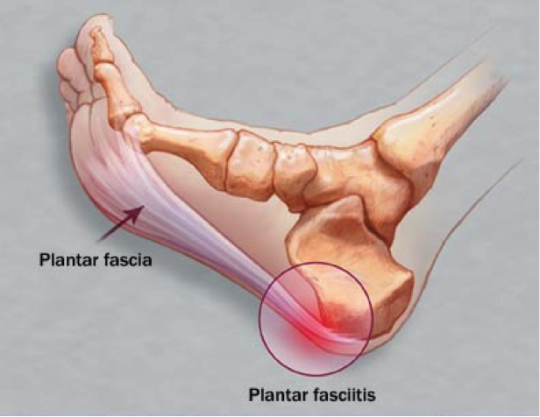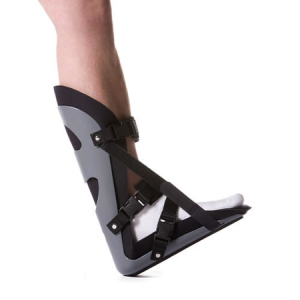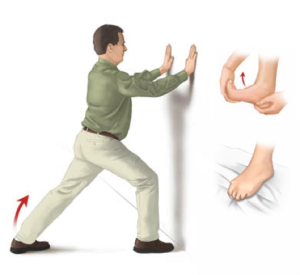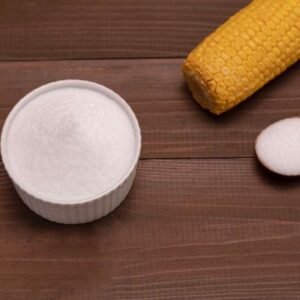
Walk Away From Foot Pain With This Easy Trick
- Is this common ailment keeping you down and costing you money? Find out…
- One free and easy way to get you back in the game that doesn’t cost a dime
- Improve your mobility in just minutes a day!
Dear Reader,
“Ouch!” I screamed as I got out of the bed this morning.
I’ve spent the last few days hiking through the winding trails of the New River Gorge in West Virginia. Needless to say, my feet hurt!

I think the view was worth it – sore feet and all!
As soon as my feet hit the floor this morning, I felt an all-too-familiar shooting pain and extreme discomfort in my heels and on the tops of my feet.
While my feet are still very sore, after a few minutes of movement, they began to feel a little relief.
And that’s when I knew — it’s back. My terribly uncomfortable plantar fasciitis is back.
This means mornings filled with crippling pain and evenings of lying on the couch with aching feet.
Even though I had a moment of sheer panic, I soon figured out that I will be just fine — I know how to relive it. I will share my secret in a bit.
If you are one of the millions who have experienced the agony of plantar fasciitis, then you know this type of panic — the concern your mobility and lifestyle will be hampered by this common condition.
If fact, this condition is so painful, Americans spend an estimated $192–376 million on plantar fasciitis treatments every year.1
Fortunately, a few years ago, when I spent my weeks working long hours on my feet, I found a natural way to relive the symptoms of this painful condition and get back on my feet in no time.
And the best part — they can be done at home for no cost!
I will share this in a bit. First, let’s take a look at how plantar fasciitis knocks you off your feet.
![]() Foot Fire
Foot Fire
The plantar fascia is a dense band of tissue (or ligament) that runs along the bottom of your foot and joins your toes to your heel bone — because of this, plantar fasciitis is often mistaken for heel spurs.
This tissue supports and absorbs shock in the arch of your foot and is shaped like a bow. When tension on the plantar fascia becomes too great, it can result in tears and inflammation in the band — causing the great pain in either one foot or both of your feet.

Photo credit: Mayoclinic.org
Certain medical conditions, like obesity or abnormal foot arches, can increase your chances of experiencing this condition. However, your daily activities and age may be the greatest contributors. Here are a few factors:
- People ages 40–60 are the most likely to experience plantar fasciitis
- Long-distance running, hiking, dancing, aerobic exercise, and even walking can lead to early-onset symptoms
- Wearing improper shoes
- Working long hours on your feet — particularly occupations where you’re standing or walking on hard surfaces.
When my plantar fasciitis was at its worst, I was spending about 14 hours a day standing and walking on concrete floors.
At one point, the burning aches in my feet had become so intense my walking patterns changed in order to curtail the pain. After a few days of this, the pain shifted to my knees, hips, and back.
If any of this sounds familiar to you, don’t worry, I am going to show you how to ease the pain.
![]() Get Back on Your Feet Naturally
Get Back on Your Feet Naturally
After almost six months of pain and multiple unsuccessful attempts at relief with wonky braces and over-the-counter pain relievers, I was almost defeated.

Imagine trying to get a good night’s sleep with this contraption strapped to your foot.
photo credit: physioroom.com
Then I finally found something that worked. Something free and simple — stretching.
And it seems like I wasn’t alone.
Dr. Joy Rowland, a podiatrist at the Cleveland Clinic, agrees that stretching is vital. “Stretching is a big part of treatment for plantar fasciitis,” said Dr. Rowland. “We have to allow that ligament to stretch rather than pull.”2
I use the following three stretches:

Photo credit: Mayoclinic.org
To do the stretch on the left, stand with your hands against the wall with a slight bend in the elbows, back leg straight with the heel down. Then gently move your hips toward the wall until you feel the stretch in your calf muscle. Switch legs and repeat.
The top right stretch requires you to sit down. Next, grab your toes and slowly pull them toward you. This should create a stretch in the bottom of the foot. Switch feet when complete.
To complete the stretch on the bottom right, you will need a towel. Place it on the floor and grab the towel with your toes and bring it toward you.
For all of these stretches, be sure to hold or repeat each one for at least 30 seconds and not to bounce during the stretch. Complete two repetitions two–three times a day.
As always, be sure to check with your doctor before starting a stretching routine. And it’s a good idea to check in anyways if your plantar fasciitis is causing you trouble.
After about two weeks of doing this sequence of stretches daily, my foot pain totally subsided and I was able to walk comfortably.
I did the stretches twice today and I am hoping to hit the trail with less pain tomorrow. I don’t want to miss any of the breathtaking sites here in Wild, Wonderful West Virginia.
Live well,

Natalie Moore
Managing editor, Living Well Daily
P.S. I will be on the road for a bit brining you exciting and unique stories from the Appalachian Mountains. Be sure to stay tuned in!
Ed. Note: Please send your feedback: nmoore@lfb.org – and click here to like us on Facebook.
Sources
[2] Easing a common source of heel pain
[3] Diseases and Conditions: Plantar fasciitis
Written By Natalie Moore
Natalie Moore is a dedicated health researcher with a passion for finding healthy, natural, and science-based solutions. After a decade of direct healthcare experience in western and natural medicine, she was involved in public health research before joining Living Well Daily.
View More Free Articles
Stop Obsessing Over Diet Trends
Can we stop with the endless diet debates already? Every other week there’s a new headline shouting about which diet is best for weight loss, heart health, or diabetes. Paleo, keto, low-carb, high-protein… it’s exhausting. And now, a new meta-analysis is out comparing the Mediterranean diet, the DASH diet, and something called AHEI (that’s “Alternative...
A New Reason to Ditch Processed Junk
If you’ve ever walked the inside aisles of your local grocery store and thought, “This is all just junk,” your instincts were spot on. A new study published in the journal Thorax just added another red flag to the list of dangers linked to ultra-processed food—a 41 percent higher risk of lung cancer. That’s right....
When Being Winded on Stairs Is Serious (And When It Isn’t)
I had an athlete visit me recently because he experienced shortness of breath while climbing stairs. He is in great shape, so he was worried about what it might mean. “Doc,” he said, “I run five miles three times a week. Why am I huffing and puffing after two flights of stairs?” His concern is...
Study EXPOSES Hidden Danger Lurking in Your Car
We think of our homes and cars as safe havens. But according to a startling new study, they may be flooding your lungs with microscopic plastic particles—every single day. Researchers in France recently found that adults inhale an average of 68,000 microplastic particles daily from indoor air alone. To put that in perspective, that’s about...
Mailbag: Is Modern Food Making You Snore?
“What can cause snoring, and is there a way to correct this issue?” —Seeking Silence Hi Seeking, Snoring happens when the soft tissues in your throat relax and vibrate as air passes through during sleep. While several factors can cause snoring—from sleep position to nasal congestion—I want to share one trigger that might surprise you....
Simple Food Swap SLASHES Dementia Risk 28%
Let’s be honest… who would jump at the chance to cut their dementia risk by 28 percent. And no, you don’t need to run marathons, survive on broccoli, or learn to play the zither (whatever that is) to make it happen. All it takes is one easy swap—something that’s probably already in your refrigerator. Researchers...
This SMART Floss Exposes Hidden Health Danger
Scientists have created dental floss that doesn’t just clean between your teeth—it also tracks your stress while you’re flossing. Now, I know what you’re thinking… “Great—now even flossing is going to stress me out by telling me how stressed I am.” But this fascinating new tool from Tufts University could be a game-changer for understanding...
Is This "Safe" Sweetener Damaging Your Brain?
The headlines are alarming… “Popular Sugar Substitute Linked to Brain Cell Damage” and “Erythritol Could Damage Critical Brain Barrier” are just two of the dozens I’ve spotted recently. But before you toss every sugar-free product in your pantry, let’s take a closer look at what this study actually shows—and what it doesn’t. The latest research...
This Summer Threat Could SPIKE Your Blood Sugar
Picture this… It’s another scorching hot summer day. You crank up the air conditioning while watching the weather forecast, which predicts yet another “record-breaking” heat wave. It’s starting to feel like just another miserably uncomfortable summer. But what you might not realize is that—if you have diabetes—those rising temps could do far more damage to...
Move Over Yogurt—5 Foods That Pack MORE Probiotics
Let’s talk about your gut. The microbiome is the collection of trillions of bacteria and other tiny organisms that live in and on your body—especially in your gut—and help keep you healthy. I’ve written often about how vital it is to maintain a healthy microbiome. And you might have dutifully added yogurt to your shopping...









